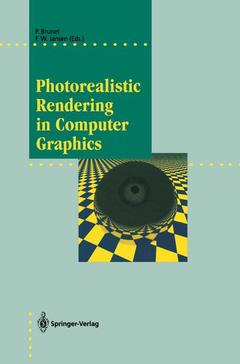Description
Photorealistic Rendering in Computer Graphics, Softcover reprint of the original 1st ed. 1994
Proceedings of the Second Eurographics Workshop on Rendering
Focus on Computer Graphics Series
Language: English
Subject for Photorealistic Rendering in Computer Graphics:
Publication date: 11-2012
282 p. · 15.5x23.5 cm · Paperback
282 p. · 15.5x23.5 cm · Paperback
Description
/li>Contents
/li>
Photorealistic rendering strives to generate images from computer modeled scenes with an image quality as close to real life as possible. A major issue in rendering is simulation of local and global light reflection in a scene. Both ray tracing and radiosity algorithms capture only some of the possible light reflection phenomena. Recently developed two-pass algorithms combine the ray tracing and radiosity approaches and are able to capture the whole range of light reflection. This book is a collection of papers discussing the latest developments, including a new range of improvements, in stochastic sampling strategies, radiosity form factor calculation, and parallel processing for ray tracing and radiosity. A number of papers on rendering applications in interior design, lighting design, and remote sensing conclude the volume. The contributions are revised versions of papers originally presented at the Second Eurographics Workshop on Rendering, held in Barcelona, Spain, in May 1991. The book fully reflects the state of the art in rendering and presentsa wide variety of novel techniques. It will interest researchers and students in computer graphics, as well as designers who want to apply rendering techniques for realistic simulation in lighting design, interior design, and architecture.
The State of the Art in Physically-based Rendering and its Impact on Future Applications.- Adaptive Shadow Testing for Ray Tracing.- An Adaptive Sampling Technique for Multidimensional Integration by Ray-Tracing.- The Simulation of Radiant Light Transfer with Stochastic Ray-Tracing.- Unbiased Variance Reduction for Global Illumination.- Direct Lighting Calculation by Monte Carlo Integration.- Structure-Directed Sampling, Reconstruction and Data Representation for Global Illumination.- Source Selection for the Direct Lighting Computation in Global Illumination.- The Constant Radiosity Assumption Syndrome.- Some Experiments on Adaptive Subdivision in Progressive Radiosity.- Radiosity in Computer Graphics: A Proposed Alternative to the Hemi-cube Algorithm.- Physics-Based Lighting Models: Implementation Issues.- Shaft Culling for Efficient Ray-Cast Radiosity.- Progressive Refinement Radiosity on a Transputer Network.- Parallel Processing of Progressive Refinement Radiosity Methods.- Two Parallel Approaches for a Progressive Radiosity.- An Extended Radiosity Using Parallel Ray-Traced Specular Transfers.- Subdivision of 3D Space Based on the Graph Partitioning for Parallel Ray Tracing.- Divide and Conquer Radiosity.- On the Division of Environments by Virtual Walls for Radiosity Computation.- Texture Shaping: A Method for Modeling Arbitrarily Shaped Volume Objects in Texture Space.- Color Spaces and Human Color Perception.- Visulux: A Radiosity Based Lighting Design Tool.- Synthesis of Multispectral Images of Natural Landscape.- A Rendering Pipeline for Street Lighting Simulation.- Color Plates.- List of Contributors.- Authors’ Index.
© 2024 LAVOISIER S.A.S.

